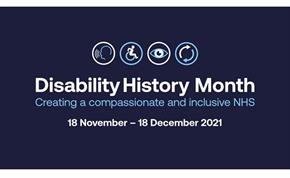
To mark Disability History Month, Zoe talks about her diagnosis of Autistic Spectrum Disorder and gives some background on the disability.
My name is Zoe, I have Autistic Spectrum Disorder (ASD) with an Asperger’s profile.
I was diagnosed in adulthood following diagnosis of my children which brought a realisation that their condition had been inherited from me. I hid my condition for a long time as I didn’t want anyone to see me as less able. Until I realised it was actually ASD that has helped me get to where I am in life.
ASD shouldn’t change perceptions of who I am, I hope it creates a better understanding of me. This is my opportunity to talk about it, make it unhidden and increase understanding of the impact to daily living and working so it doesn’t have to be hidden or unknown to others.
What is Autistic Spectrum Disorder (ASD)?
ASD is a lifelong condition which affects the way a person communicates, thinks, and behaves - how we experience the world around us. It is more common than you may think, approximately 1 person in every 100 in the UK has a diagnosis. Many other people are undiagnosed.
No two individuals with autism are alike – they may share common traits, but their autism affects them in different ways – hence the use of the word spectrum.
Managing the Impacts of ASD
Social Skills - A typical Asperger’s trait is sitting on the outside and watching in knowing that there is something different. Throughout life I have watched and learned how to behave in different settings then I apply what I have learned. This helped me overcome my intense shyness and I now enjoy spending time with others, with quiet time after to recharge from the sensory overload of a social world. I have built a skill set of being adaptable and flexible through conscious learning. I ask questions to understand the world around me. I have transferred these learnings and adjustments to my working skillset to help me in my role.
Change to routines, timings, last minute meetings - People with ASD work well with routine. However, my working life doesn’t always have this. I manage the impact by consciously adjusting my mind to expect change is likely to happen. I listen and again ask questions to help me adjust to anything new. I try where I can to manage my reactions to change or timings as a typical ASD trait is to miss the cue on filtering!
Sensory Processing: Environmental - During the pandemic, moving to virtual working was a challenge as the social and environmental cues in the virtual meeting room differ, knowing when to speak and not, multiple competing noises and alerts, multiple chat messages, emails pinging on screen. Add in off screen factors at home like a knock on the door, change in lighting, all a recipe for a sensory overload.
Sensory Processing: Movement and sensory breaks - Working virtually in front of a screen all day can limit movement: I need regular movement to keep my focus, this is sometimes referred to as stimming. For children a fidget toy is used to help them focus on schoolwork or as a calming aide. To keep my concentration, I sometimes have to move in my chair or fidget with a pen. Where I can I come away from MS Teams and make my phone calls whilst walking around. I worry if this appears like I’m not focusing or distracted when in fact this is exactly how I am focussing.
Special interest focus and drive - A typical trait of Asperger’s is having an intense focus on a task. This is great when a piece of work captures my attention as I have a sense of purpose to get to completion on time and an overriding need to do it as well as I can. I have to manage a fear of failure or not meeting a deadline that can sometimes feed this intense focus to be mindful of the impact to my mental health. This drive and dedication to want to do the best job I can for everyone I work with has helped me move my career forward. However, I have to consciously manage this intense focus to not be at the expense of everyday aspects of life (who likes ironing anyway!).
The Learning
Adjustments for people with autism are quite often extra layers of thinking or processing that we need to add into a task, meaning additional effort which people without autism don’t necessarily need. Over time and with practice for some tasks we can reduce or manage the effort as it begins to form part of a routine for us.
I don’t see my ASD, my Asperger’s, as a lifelong disadvantage, instead, with additional layers of effort and adjustment, it has enabled me in life and work.
Autism: Make it unhidden by talking about it.
Published 7th December 2021